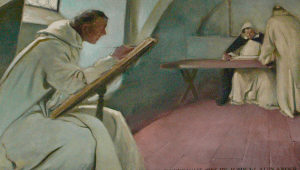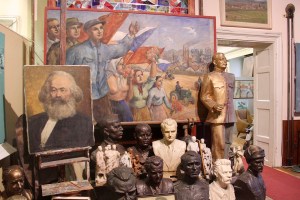We support our Publishers and Content Creators. You can view this story on their website by CLICKING HERE.
What is true of architecture, art and music is equally true of literature. Throughout the history of Christendom, great literature has paid homage to sacred liturgy and the sacraments.
Author’s Note: On the evening of Wednesday, September 25 I was honoured to give the keynote address at the opening of the annual conference of the Society for Catholic Liturgy in Houston, Texas. I spoke from the scantiest of notes, as is my wont, which means that the written text of the address does not exist. I thought, however, that it would be good were I to flesh out the notes into a fully-fledged essay, reflecting what I said at the conference, while the talk is still fresh in my mind. The following is the fullness of the fledging….
 Considering that the sacraments and the liturgy have always been at the sacred heart of Christendom, it is little surprise that the greatest creative works of Christian civilization have reflected this. Architectural edifices soar heavenwards, churches and cathedrals serving as glorious tabernacles enshrining the Blessed Sacrament and the holy sacrifice of the Mass. The greatest masterpieces of art reflect the key moments of the life of Christ, which are themselves the key moments of the liturgical year: the Nativity, the Crucifixion, the Resurrection and the Ascension. Sacred music has been composed as a handmaid to the Church’s liturgy: Gregorian chant, polyphony, and the great musical settings of the Mass.
Considering that the sacraments and the liturgy have always been at the sacred heart of Christendom, it is little surprise that the greatest creative works of Christian civilization have reflected this. Architectural edifices soar heavenwards, churches and cathedrals serving as glorious tabernacles enshrining the Blessed Sacrament and the holy sacrifice of the Mass. The greatest masterpieces of art reflect the key moments of the life of Christ, which are themselves the key moments of the liturgical year: the Nativity, the Crucifixion, the Resurrection and the Ascension. Sacred music has been composed as a handmaid to the Church’s liturgy: Gregorian chant, polyphony, and the great musical settings of the Mass.
What is true of architecture, art and music is equally true of literature. Throughout the history of Christendom, great literature has paid homage to sacred liturgy and the sacraments.
The Beowulf poet was almost certainly a Benedictine monk who was probably writing in the late seventh or early eighth century, making him a contemporary or near contemporary of St. Bede, that other great Benedictine of Anglo-Saxon England. It is no surprise, therefore, that the poem should reflect Bede’s defence of the sacraments and sacramental grace, especially in opposition to the British heresy of Pelagianism which denied the need for the sacraments. (Pelagius claimed that individuals could get to heaven purely through the triumph of their own will, thereby negating the need for grace in general and sacramental grace in particular.) Throughout the poem, Beowulf insists that his victory over the demonic foe was only possible due to divine assistance (grace) and it is evident that the magic or miraculous sword, a gift from God, is plainly a metaphor for grace.
Moving to the high Middle Ages of the thirteenth and to the great St. Thomas Aquinas, we discover that the Church’s greatest theologian and philosopher is also one of Christendom’s greatest poets. The sequence of hymns he composed for the feast of Corpus Christi is one of the great masterpieces of literature. These hymns, Lauda Sion, Panga lingua, Sacra solemniis and Verbum supernum, set to gloriously melodious chant, serve as a musical monstrance from which the glory of the Eucharist shines forth epiphanously.
If St. Thomas Aquinas is the greatest Christian theologian and philosopher, his disciple, Dante Alighieri, is arguably the greatest Christian poet. His Divine Comedy plumbs the depths of human sin and climbs penitentially and purgatorially towards the heavenly paradise, doing so against the backdrop of the Paschal Triduum. Dante’s great poem begins in the dark wood on Maundy Thursday, descends into hell on Good Friday and emerges into the light of the sun at the foot of Mount Purgatory on Easter Sunday morning. At the summit of Mount Purgatory, in the Earthly Paradise, the reader is presented with the Pageant of the Sacrament, a symbolic masque showing salvation history within the allegorical setting of a Corpus Christi possession.
The late medieval chivalric romance, Sir Gawain and the Green Knight, begins and ends in the Christmas season. Furthermore, Sir Gawain announces his intention to embark on the quest for the Green Knight on the Feast of All Hallows and sets out on the following day, the Feast of All Souls, which sets the penitential and purgatorial theme of the poem. Sir Gawain finds himself lost in the wastes of Wales throughout the whole of the penitential season of Advent and is granted the miraculous vision of the Green Knight’s castle in answer to a prayer on Christmas Eve that he might be able to attend Mass on the Feast of Our Lord’s Nativity.
By the late fourteenth century, when the anonymous English poet was writing Sir Gawain and the Green Knight, the Italian Renaissance was heralding a new spirit of cultural flowering which would mark the transition from the medieval to the modern period of human history. Although this transformation of the culture of Christendom would prove radical and even revolutionary, some of the greatest literature of the Early Modern and Modern ages would continue to be inspired by the liturgy of the Church. This will be the focus of the next essay in which we’ll celebrate “liturgy and literature in the modern age” from Shakespeare to Tolkien.
The Imaginative Conservative applies the principle of appreciation to the discussion of culture and politics—we approach dialogue with magnanimity rather than with mere civility. Will you help us remain a refreshing oasis in the increasingly contentious arena of modern discourse? Please consider donating now.
The featured image (detail) is “The Manuscript [medieval scribes]” by John White Alexander (1856–1915), from the cycle “The Evolution of the Book,” and is in the public domain, courtesy of Wikimedia Commons.
Share This Story, Choose Your Platform!
Go to Top

 Conservative
Conservative  Search
Search Trending
Trending Current News
Current News 






